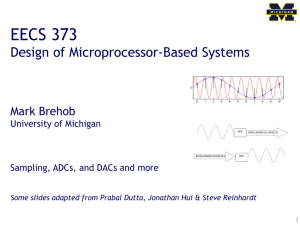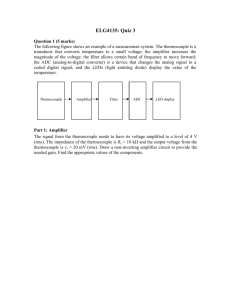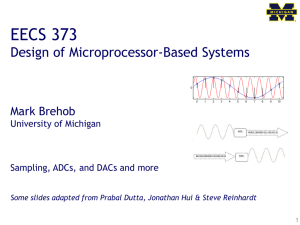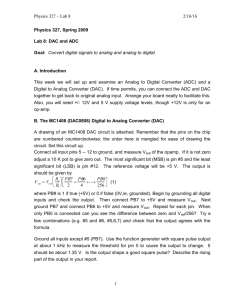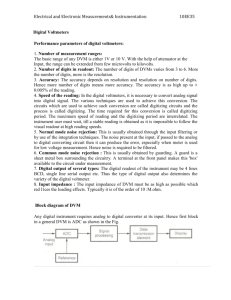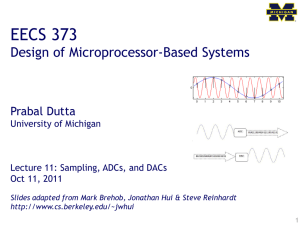AN-880 APPLICATION NOTE
advertisement
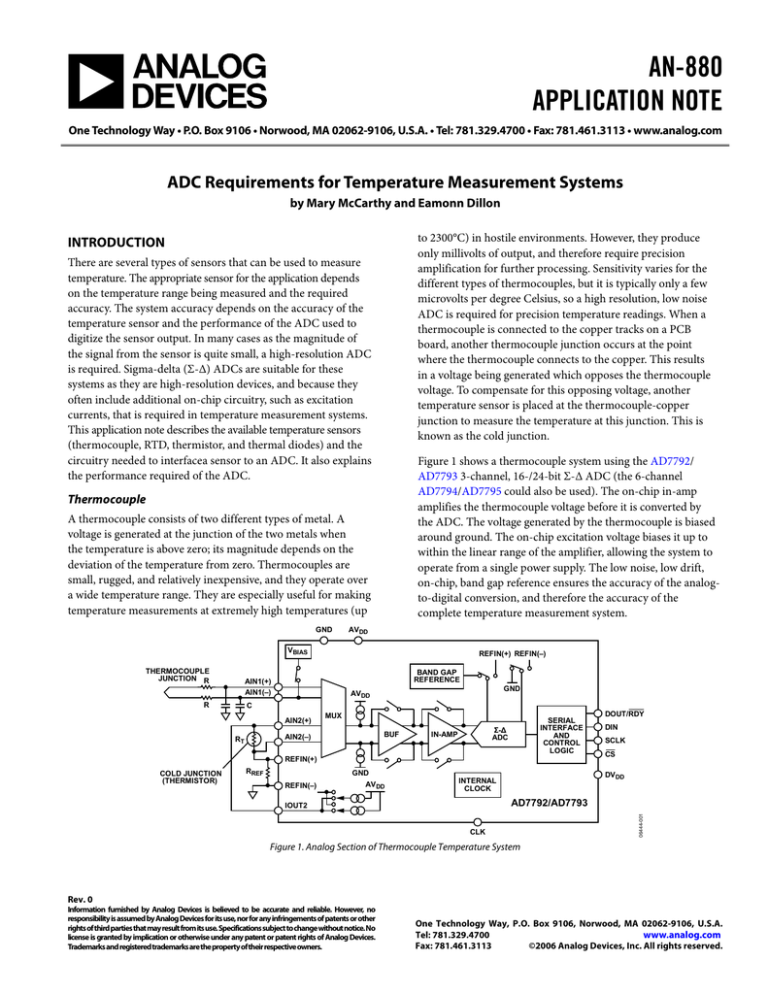
AN-880 APPLICATION NOTE One Technology Way • P.O. Box 9106 • Norwood, MA 02062-9106, U.S.A. • Tel: 781.329.4700 • Fax: 781.461.3113 • www.analog.com ADC Requirements for Temperature Measurement Systems by Mary McCarthy and Eamonn Dillon to 2300°C) in hostile environments. However, they produce only millivolts of output, and therefore require precision amplification for further processing. Sensitivity varies for the different types of thermocouples, but it is typically only a few microvolts per degree Celsius, so a high resolution, low noise ADC is required for precision temperature readings. When a thermocouple is connected to the copper tracks on a PCB board, another thermocouple junction occurs at the point where the thermocouple connects to the copper. This results in a voltage being generated which opposes the thermocouple voltage. To compensate for this opposing voltage, another temperature sensor is placed at the thermocouple-copper junction to measure the temperature at this junction. This is known as the cold junction. INTRODUCTION There are several types of sensors that can be used to measure temperature. The appropriate sensor for the application depends on the temperature range being measured and the required accuracy. The system accuracy depends on the accuracy of the temperature sensor and the performance of the ADC used to digitize the sensor output. In many cases as the magnitude of the signal from the sensor is quite small, a high-resolution ADC is required. Sigma-delta (Σ-Δ) ADCs are suitable for these systems as they are high-resolution devices, and because they often include additional on-chip circuitry, such as excitation currents, that is required in temperature measurement systems. This application note describes the available temperature sensors (thermocouple, RTD, thermistor, and thermal diodes) and the circuitry needed to interfacea sensor to an ADC. It also explains the performance required of the ADC. Figure 1 shows a thermocouple system using the AD7792/ AD7793 3-channel, 16-/24-bit Σ-Δ ADC (the 6-channel AD7794/AD7795 could also be used). The on-chip in-amp amplifies the thermocouple voltage before it is converted by the ADC. The voltage generated by the thermocouple is biased around ground. The on-chip excitation voltage biases it up to within the linear range of the amplifier, allowing the system to operate from a single power supply. The low noise, low drift, on-chip, band gap reference ensures the accuracy of the analogto-digital conversion, and therefore the accuracy of the complete temperature measurement system. Thermocouple A thermocouple consists of two different types of metal. A voltage is generated at the junction of the two metals when the temperature is above zero; its magnitude depends on the deviation of the temperature from zero. Thermocouples are small, rugged, and relatively inexpensive, and they operate over a wide temperature range. They are especially useful for making temperature measurements at extremely high temperatures (up GND AVDD VBIAS BAND GAP REFERENCE AIN1(+) AIN1(–) R GND AVDD C AIN2(+) MUX BUF AIN2(–) RT SERIAL INTERFACE AND CONTROL LOGIC Σ-Δ ADC IN-AMP REFIN(+) COLD JUNCTION (THERMISTOR) RREF GND REFIN(–) AVDD DOUT/RDY DIN SCLK CS DVDD INTERNAL CLOCK AD7792/AD7793 IOUT2 CLK 06444-001 THERMOCOUPLE JUNCTION R REFIN(+) REFIN(–) Figure 1. Analog Section of Thermocouple Temperature System Rev. 0 Information furnished by Analog Devices is believed to be accurate and reliable. However, no responsibility is assumed by Analog Devices for its use, nor for any infringements of patents or other rights of third parties that may result from its use. Specifications subject to change without notice. No license is granted by implication or otherwise under any patent or patent rights of Analog Devices. Trademarks and registered trademarks are the property of their respective owners. One Technology Way, P.O. Box 9106, Norwood, MA 02062-9106, U.S.A. Tel: 781.329.4700 www.analog.com Fax: 781.461.3113 ©2006 Analog Devices, Inc. All rights reserved. AN-880 The ADC has differential analog inputs and accepts a differential reference, allowing a ratiometric configuration to be implemented. In Figure 2, the reference voltage for the ADC is also generated using the matched current sources. This reference voltage is developed across the precision resistor, RREF, and is applied to the differential reference inputs of the ADC. This scheme ensures that the analog input voltage span remains ratiometric to the reference voltage. Any errors in the analog input voltage due to the temperature drift of the RTD current source are compensated by the variation in the reference voltage. The temperature at the cold junction is measured using a resistance temperature detectors (RTD) or thermistor (a thermistor, RT, is shown in Figure 1). The resistance of both of these devices varies with temperature. On-chip constant current sources provide the required excitation currents. A ratiometric configuration is used for this measurement, that is, the reference for the ADC is also generated from the same excitation current using a precision resistor. Using a ratiometric configuration makes the measurement of the cold junction temperature immune to variations in the excitation current because variations in the excitation current will alter both the voltage generated by the sensor and the precision resistor by the same amount and therefore has no impact on the analog to digital conversion. Thermistor A resistance of thermistors also varies with temperature, but they are less accurate than RTDs. A single current source is normally used with a thermistor. As with the RTD, using a precision resistor for the reference, with a current source driving the precision reference resistor along with the thermistor means that a ratiometric configuration is achieved. This means that the accuracy of the current source is not important, as drift of the current source affects both the thermistor and reference resistor, thus canceling its effect. Thermistors are normally used for cold-junction compensation in thermocouple applications. Their nominal resistance is normally 1000 Ω or higher. RTD The resistance of RTDs varies with temperature. Typical elements used for RTDs are nickel, copper, and platinum, with 100 Ω and 1000 Ω platinum RTDs being the most common. RTDs are useful for measuring temperatures from –200°C to +800°C with a near linear response over the complete temperature range. An RTD can consist of three wires or four wires. Figure 2 shows how a 3-wire RTD is connected to the ADC. RL1, RL2, and RL3 are the resistances of the RTD’s leads. Thermal Diodes AVDD REFIN(+) RL2 RL3 AIN1(+) AIN1(–) GND BUF IOUT2 REFIN(+) RREF REFIN(–) INAMP GND AD7792/AD7793 Σ-Δ ADC SERIAL INTERFACE AND CONTROL LOGIC DOUT/RDY DIN SCLK CS AVDD GND INTERNAL CLOCK DVDD REFIN(+) 06444-002 RTD MUX RL1 REFIN(–) AVDD Thermal diodes are also used for temperature measurements. In these systems, the temperature is calculated by measuring the base-emitter voltage of a diode-connected transistor. Two different currents are passed through the diodes. The baseemitter voltage is measured in each case. With a known current ratio, the temperature can be accurately calculated by measuring the difference in the base-emitter voltage at the two currents. CLK BAND GAP REFERENCE IOUT1 AIN1(+) Figure 2. Analog Section of RTD Temperature System To fully optimize a 3-wire RTD configuration, two identically matched current sources are required. In this 3-wire configuration, the lead resistances cause errors if only one current source (IOUT1) is used because the excitation current flows through RL1, developing a voltage error between AIN1(+) and AIN1(–). The second RTD current source (IOUT2) is used to compensate for the error introduced by the excitation current flowing through RL1. The absolute accuracy of each current source is not important, but good matching of the two current sources is essential. The second RTD current flows through RL2. Assuming RL1 and RL2 are equal (the leads are normally of the same material and of equal length), and IOUT1 and IOUT2 match, the error voltage across RL2 cancels the error voltage across RL1, and no error voltage is developed between AIN1(+) and AIN1(−). Twice the voltage is developed across RL3, but this is a common-mode voltage, so it does not introduce errors. AIN1(–) REFIN(–) AVDD GND BUF REFIN(+) REFIN(–) INAMP GND AD7792/AD7793 Σ-Δ ADC INTERNAL CLOCK SERIAL INTERFACE AND CONTROL LOGIC DOUT/RDY DIN SCLK CS DVDD CLK Figure 3. Analog Section of Thermal Diode Temperature System In Figure 3, the AD7792/AD7793 excitation currents are programmed to 10 μA and 210 μA (other options are also available). The 210 μA excitation current is passed through the diode first. The base-emitter voltage of the transistor is measured by the ADC. The measurement is then repeated using the 10 μA current. This means that the current is reduced by a factor of 21. The absolute value of the currents is not critical to the measurement, but a fixed ratio is required. Rev. 0 | Page 2 of 4 06444-003 BAND GAP REFERENCE IOUT1 MUX GND AN-880 Because the current sources are integrated on the chip, the AD7792/AD7793 guarantees well-matched current sources, and thus stable current ratios. The constant current ratio is necessary to remove parasitic errors that would affect the temperature measurement. The two base-emitter voltage readings are sent to a microcontroller to calculate the temperature. T= The Σ-Δ modulator converts the sampled input signal into a digital pulse train whose ones density contains the digital information. The Σ-Δ modulator also performs noise-shaping. With noise-shaping, the noise in the band of interest is pushed out of band into the frequency range not being used. The higher the order of the modulator, the greater the noise-shaping that occurs in the band of interest. However, higher order modulators are prone to instability. Therefore, a balance must be obtained between the order of the modulator and stability. In low bandwidth Σ-Δ ADCs, a second- or third-order modulator is normally used, so the devices are not prone to instability. QΔV BE nK ln( N ) where: n = Ideality Factor = measured quantity, K = Boltzmanns constant, N = ratio of IC2 to IC1, Q = charge on an electron, ΔVBE is measured by the ADC. ADC REQUIREMENTS Architecture The measurements in temperature systems are typically low speed (up to 100 samples per seconds), so a low bandwidth ADC is suitable. However, the ADC must have high resolution. Their low bandwidth and high resolution make Σ-Δ ADCs ideal for these applications. With this architecture, the analog input is continuously sampled by a switched capacitor front-end, with the sampling frequency being considerably higher than the bandwidth of interest (see Figure 4). For example, the AD7793 has an on-chip 64 kHz clock. The analog signal being measured is close to dc, but is oversampled by a factor of K (KfS), reducing the quantization noise in the baseband. The quantization noise is spread from dc up to half the sampling frequency (KfS /2). Therefore, using a higher sampling frequency increases the range over which the quantization noise is spread and reduces the noise in the band of interest. fS KfS OVERSAMPLING + DIGITAL FILTER fS + DECIMATION ADC DIGITAL DEC FILTER KfS ADC OVERSAMPLING + NOISE SHAPING + DIGITAL FILTER + DECIMATION fS fS fS 2 DIGITAL FILTER REMOVED NOISE fS 2 KfS 2 KfS REMOVED NOISE DIGITAL DEC FILTER fS 2 KfS 2 KfS Signals from temperature sensors are, in general, quite small, and the change of a few degrees in temperature cause the corresponding analog voltage generated by temperature sensors such as thermocouples and RTDs to change by a few hundred microvolts at most. This results in a typical full-scale analog output voltage that is only in the millivolt range. The full-scale range of the ADC is normally ±VREF if a gain stage is not present. To optimize the performance of the ADC, most of its analog input range should be used. This highlights the importance of gain when measuring temperature using these sensors. Without any gain, only a small fraction of the full-scale range of the ADC is used, resulting in the loss of resolution. 06444-004 ADC Gain An instrumentation amplifier allows a low noise, low drift gain stage to be developed. Low noise and low drift are essential so that the voltage changes due to a change in temperature are larger than the noise due to the instrumentation amplifier. The gain on the AD7793 can be programmed to 1, 2, 4, 8, 16, 32, 64, or 128. Using the maximum gain setting of 128 and the internally generated voltage reference, the full-scale range of the AD7793 is ±1.17 mV/128 mV or approximately ±10 mV. This allows the high resolution feature of the ADC to be used to maximum effect without any need for any external amplifier components. QUANTIZATION NOISE = q/ 12 q = 1LSB NYQUIST OPERATION The digital filter that follows the modulator decimates the modulator output to give a valid data conversion result. This filter also removes the out of band noise. Images of this filter occur at multiples of the master clock. Therefore, using Σ-Δ architecture means that the only external components that are required are a simple R-C filter to remove images of the digital filter that occur at multiples of the master clock frequency. The Σ-Δ architecture allows 24-bit ADCs with a peak-to-peak resolution of up to 20.5 bits to be developed (20.5 stable or flicker free bits). Figure 4. Noise Spectrum Effects due to Oversampling, Digital Filtering, Noise Shaping, and Decimation Rev. 0 | Page 3 of 4 AN-880 50 Hz/60 Hz Rejection Low Power The digital filter on board Σ-Δ ADCs is useful to reject other noise sources along with the out-of-band quantization noise. One source of noise is tones introduced from the mains power supply. When devices are powered from the mains, there will be mains-generated frequencies at 50 Hz and its multiples in Europe, and at 60 Hz and its multiples in the U.S. The low bandwidth ADCs mainly use sinc filters. The AD7793 has four filter options, with the ADC automatically selecting the filter type being used depending upon the update rate. A sinc3 filter is used when the update rate equals 16.6 Hz. As shown in Figure 5, the sinc3 filter has notches in the frequency spectrum. At an output word rate of 16.6 Hz, these notches can be used to provide simultaneous 50 Hz or 60 Hz rejection. A lot of temperature systems are not mains-driven. In some industrial applications, such as temperature monitoring in factories, the complete temperature system containing the sensor (ADC) and microcontroller are contained on a standalone board, which is powered from a 4 mA to 20 mA loop. Therefore, the standalone board has a current budget of 4 mA maximum. Portable equipment such as portable gas analyzers in mines require temperature to be measured along with the presence of gases. These systems are operated from a battery, with the aim being to maximize the lifetime of the battery. In these applications, low power is essential, but high performance is still required. With the AD7793, the current consumption is 500 μA maximum so it continues to meet the high performance specifications of the temperature system while consuming a comparatively low current. 0 CONCLUSION –20 (dB) –40 –60 –100 0 20 40 60 80 100 120 140 160 180 FREQUENCY (Hz) 200 06444-005 –80 Figure 5. Frequency Response when the Update Rate Equals 16.6 Hz Chopping Undesirables such as offset and other low frequency errors are always present within a system, including temperature measurement systems. Chopping is a feature inherent to the AD7793 and is used to remove these undesirables. Chopping works by alternately inverting (or chopping) at the input multiplexer to the ADC. An ADC conversion is then performed for each phase of chop (positive phase and negative phase). These two conversions are then averaged by the digital filter stage. The effect is to virtually eliminate any offset errors arising within the ADC, and, more importantly, to minimize any offset drift with temperature. The ADC and system requirements for a temperature measurement system are quite stringent. The components required for each type of temperature sensor differ, but the analog signals generated by these sensors are always quite small. Thus, they need to be amplified by a gain stage whose noise is low so that the amplifiers noise does not swamp the signal from the sensor. Following the amplifier, a high resolution ADC is required so that the low level signal from the sensor can be converted into digital information. ADCs that use a Σ−Δ architecture are suitable for such applications because high resolution, high precision ADCs can be developed using these topologies. Along with the ADC and gain stage, a temperature system requires other components such as excitation currents or voltage references. Again, these must be low drift, low noise components so that the system accuracy is not degraded. Initial inaccuracies such as offset can be calibrated out of the system, but the drift of the components with temperature must be low to avoid error introduction. Finally, while power consumption is a concern for any portable application, a lot of systems, which were previously supplied by the main power supply, are now being developed on standalone boards so power consumption is becoming increasingly important. ©2006 Analog Devices, Inc. All rights reserved. Trademarks and registered trademarks are the property of their respective owners. AN06444-0-12/06(0) Rev. 0 | Page 4 of 4

